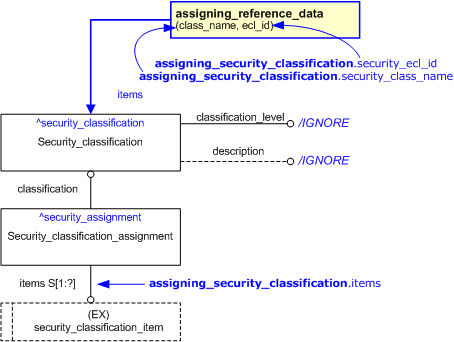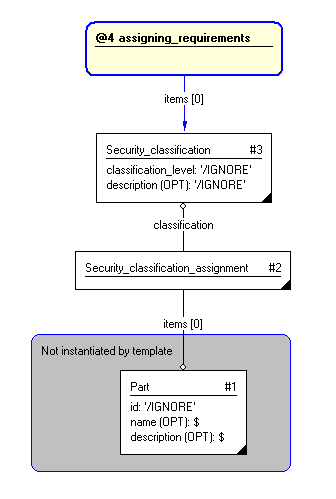
| Template:— assigning_security_classification (asg_sec) | Date: 2008/02/15 10:23:44 Revision: 1.17 |
This section specifies the template assigning_security_classification.
NOTE An explanation of a template and the associated instantiation path is provided in the Template overview section.
This template describes how to represent the assignment of a security classification to an item.


target
is the parameter to which the
Security_classification
is bound.
target
is the parameter to which the
Security_classification_assignment
is bound.
| Entity in path | Value | Inherited from |
| Security_classification.classification_level | '/IGNORE' | — |
| Security_classification.description | '/IGNORE' | — |



NOTE this characterization is optional.
The date and time when the Security_classification was assigned can be represented by assigning a date and time (using the relationship Date_or_date_time_assignment) to the Security_classification_assignment using the assigning_time.
NOTE The assignment of dates and times is described in the capability C036: assigning_date_time (NB Capabilities are not documented in this release of the PLCS standard) .
NOTE this characterization is optional.
The person or organization that assigned the Security_classification can be represented by using the template assigning_person_in_organization or assigning_organization.
The assignment of the person or organization (Organization_or_person_in_organization_assignment) is classified as: "Security_classifier_of" (urn:plcs:rdl:std:Security_classifier_of) to indicate that the person or organization was responsible for assigning the security classification.
NOTE this characterization is optional.
The security classification of an item may change over time. This is represented by associating a dated effectivity with the assignment of a security classification where the effectivity represents the period over which the classification was in force.
The dated effectivity is represented by using the template assigning_dated_effectivity to assign a start and end-bound date to an Security_classification_assignment.
© OASIS 2008 — All rights reserved